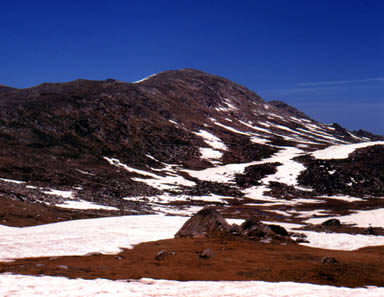There is a different world up here; a world of tall trees, thick brush and steep spurs,
a world of screeching parrots and unexpected blizzards,
a world of alpine meadows and snow-gums twisted by the wind.
– Brigitte Muir |
In Defense of Kosciuszko |
| Mount Kosciuszko, Australia’s highest peak, violates some people’s sense of perfection, and they
subject the poor peak to pusillanimous attacks. These people claim that Australia is not a continent and that Kosciuszko
is not a continent summit. Huh? Obviously, before we can define continent summits, we must define a continent. |
| There is a large gap in landmass area between Australia, with an area of 2,968,000 square miles,
and the next largest landmass Greenland, with an area of 840,000 square miles.
Australia is more than three times larger than Greenland. No other two landmasses adjacent in land area ranking have such a difference.
Historically, this gap has separated continents and islands. Australia was the smallest continent
and Greenland was the largest island. |
| Geography is not an exact science. The words continent and island evolved as our knowledge of the planet increased,
and the dividing line between them settled into the size gap between Australia and Greenland. Australia is still the smallest
continent and Greenland the largest island. A piece of land is either part of a continent or an island.
A landmass cannot be both a continent and an island. Continents and islands are mutually exclusive. As
the term continent evolved, it moved away from including outlying islands. England has always referred to France as being on
“the continent.” France has always thought of Great Britain as an island. |
| The term Oceania is also evolving. Oceania used to refer to the southwestern pacific basin
but more recently, Oceania refers to all of Earth’s oceans and islands. That
definition makes more sense to me. Oceania is the domain of all oceans and
includes all Earth’s land not on a continent. In any case, Oceania is not
a continent. Together, the seven continents and Oceania account for all Earth’s
land above sea level. This discussion is not concerned with the bottom of
the oceans. Land ends where the ocean starts. |
| The term Australasia is devolving. It sometimes indicates an area of the South Pacific that includes
Australia, Tasmania, New Zealand and other adjacent islands. The term’s lack
of adequate definition has led to a decline in its use and importance. Occasionally,
the term Australasia has been used to include Oceania—another poorly defined
term. Using either definition of Oceania, the highest peak in Oceania is 16,003-foot
Carstenz Pyramid on the island of New Guinea. |
| The highest peaks on all the continents except Australia are higher than the highest peak
in Oceania. There is no debate about their sanctity as continent summits.
Australia’s highest peak, 7,328-foot Kosciuszko, is lower than Carstenz Pyramid
and many other island peaks. This fact violates some people’s sense of how
Earth’s land should be organized. |
| People claiming that Kosciuszko is not a continent summit argue that Carstenz Pyramid is the
highest peak on the “Australasian continent,” but an Australasian continent
has never been clearly defined. New Zealanders advertise Mount Cook as the
highest peak in Australasia. In any case, attempts to define an Australasian
continent are attempts to define a continent consisting of both continents
and islands. This is like defining cats to be cats and dogs. |
| If Denali were on an Aleutian Island, it would no longer be North America’s highest peak,
it would be the highest peak in Oceania. In this hypothetical geography, some
people might try to preserve Denali’s status as a continent summit by claiming
it is part of Alaska. What if another country owned the Aleutian Islands?
Russia used to. Political boundaries change and introducing them into this
discussion produces unstable definitions for the terms continent and island. |
| Some people argue that Carstenz Pyramid is the highest peak on the Australasian continental
plate. This argument stops where the ocean begins. We measure peaks from sea
level not continental plates. In any case, Carstenz Pyramid just misses being
on the Australasian plate. |
| It is not a perfect planet. A continent summit does not have to be higher than the highest
peak in Oceania. It just so happens that Australia is a continent and Kosciuszko
is its highest peak. It just so happens that Australia is the smallest continent
and that Kosciuszko is the lowest continent summit. It just so happens that
Kosciuszko is lower than the highest peak in Oceania. It just so happens that
Kosciuszko is easy to climb. |
| It is precisely Kosciuszko’s gentle nature and humble altitude that make it valuable as a continent
summit. Kosciuszko adds a civilized note into an arena filled with savage giants.
We need that note. For me, summits are summits, continents are continents
and islands are islands. When I reached the top of Kosciuszko in 1968, I knew where I stood. |
| – Gerry Roach |

Mount Kosciuszko, Australia’s highest peak |

